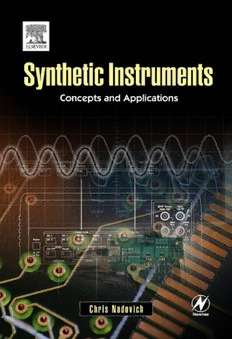
Synthetic instruments : concepts and applications PDF
Preview Synthetic instruments : concepts and applications
Synthetic Instruments This page intentionally left blank Synthetic Instruments Concepts and Applications by C.T. Nadovich AMSTERDAM • BOSTON • HEIDELBERG • LONDON NEW YORK • OXFORD • PARIS • SAN DIEGO SAN FRANCISCO • SINGAPORE • SYDNEY • TOKYO Newnes is an imprint of Elsevier Newnes is an imprint of Elsevier 200 Wheeler Road, Burlington, MA 01803, USA Linacre House, Jordan Hill, Oxford OX2 8DP, UK Copyright © 2005, Elsevier Inc. All rights reserved. No part of this publication may be reproduced, stored in a retrieval system, or transmitted in any form or by any means, electronic, mechanical, photo- copying, recording, or otherwise, without the prior written permission of the publisher. Permissions may be sought directly from Elsevier’s Science & Technology Rights Department in Oxford, UK: phone: (+44) 1865 843830, fax: (+44) 1865 853333, e-mail: [email protected]. You may also complete your request on-line via the Elsevier homepage (http://elsevier.com), by select- ing “Customer Support” and then “Obtaining Permissions.” Recognizing the importance of preserving what has been written, Elsevier prints its books on acid-free paper whenever possible. Library of Congress Cataloging-in-Publication Data (Application submitted.) British Library Cataloguing-in-Publication Data A catalogue record for this book is available from the British Library. ISBN: 0-7506-7783-X For information on all Newnes publications visit our website at www.newnespress.com 04 05 06 07 08 09 10 9 8 7 6 5 4 3 2 1 Printed in the United States of America. Contents Foreword .....................................................................................xiii Plan of this Book ................................................................................xiv Chapter Outline ..................................................................................xv Preface ........................................................................................xvii Acknowledgments ......................................................................xix What’s on the CD-ROM? ............................................................xxi Chapter 1: What is a Synthetic Instrument? ...............................1 History of Automated Measurement ....................................................1 Genesis ..................................................................................................2 Modular Instruments ............................................................................4 Synthetic Instruments Defined .............................................................5 Synthesis and Analysis .........................................................................6 Generic Hardware .................................................................................6 Advantages of Synthetic Instruments ................................................11 Eliminating Redundancy ....................................................................11 Measurement Integration ...................................................................13 Measurement Speed ............................................................................14 Longer Service Life .............................................................................15 Synthetic Instrument Misconceptions ...............................................15 Why not Just Measure Volts with a Voltmeter? .................................16 Virtual Instruments .............................................................................16 Analog Instruments ............................................................................19 Chapter 2: Synthetic Measurement System Hardware Architectures ..........................................................................21 System Concept—The CCC Architecture ........................................21 Signal Flow .........................................................................................22 The Synthetic Measurement System ..................................................23 Chinese Restaurant Menu (CRM) Architecture ...............................23 Parameterization of CCC Assets ........................................................25 Architectural Variations .....................................................................26 v Contents Compound Stimulus ...........................................................................27 Simultaneous Channels and Multiplexing .........................................28 Hardware Requirements Traceability .................................................34 Chapter 3: Stimulus .....................................................................35 Stimulus Digital Signal Processing .....................................................35 Waveform Playback ............................................................................36 Direct Digital Synthesis ......................................................................37 Algorithmic Sequencing .....................................................................39 Synthesis Controller Considerations ..................................................41 Stimulus Triggering .............................................................................42 Stimulus Trigger Interpolation ...........................................................43 The Stimulus D/A ..............................................................................44 Interpolation and Digital Up-Converters in the Codec ....................45 Stimulus Conditioning .......................................................................46 Stimulus Conditioner Linearity ..........................................................47 Gain Control ......................................................................................47 Adaptive Fidelity Improvement .........................................................49 Reconstruction Filtering .....................................................................50 Stimulus Cascade—Real-World Example ..........................................51 Chapter 4: Response ...................................................................55 Response Signal Conditioning ...........................................................55 Input Protection ..................................................................................55 Response Linearity and Gain Control ................................................56 Adaptive Techniques ..........................................................................57 The Response Codec ..........................................................................58 Fidelity and Measurement Accuracy ..................................................58 Ideal Quantization ..............................................................................60 Codec Headroom ................................................................................60 Headroom Trade-off and System Fidelity ...........................................61 Response Digital Signal Processing ....................................................62 Waveform Recorder and DSP .............................................................62 Matched Filter Demodulator ..............................................................64 Response Trigger Time Interpolator ...................................................66 Response Cascade—Real-World Example .........................................66 vi Contents Chapter 5: Real-World Design: A Synthetic Measurement System ....................................................................................69 Universal High-Speed RF Microwave Test System ............................69 Background .........................................................................................69 Logistical Goals ...................................................................................70 Technical Goals ..................................................................................70 RF Capabilities ....................................................................................70 System Architecture ...........................................................................71 Microwave Synthetic Instrument (TRM1000C) ...............................71 Supplemental Resources .....................................................................74 DUT Interface ....................................................................................74 Product Test Adapter Solutions .........................................................75 Calibration ..........................................................................................75 Primary Calibration ............................................................................75 Operational Calibration .....................................................................76 Software Solutions ..............................................................................76 Test Program Set Developer Interface ................................................77 TRM1000C Software ..........................................................................77 Conclusions .........................................................................................78 Chapter 6: Measurement Maps ..................................................81 Measurement Abstraction ..................................................................83 General Measurements .......................................................................85 Abscissas and Ordinates .....................................................................86 The Measurement Function ...............................................................86 Canonical Ordinate Algorithms .........................................................88 Multidimensional Measurements .......................................................88 Domains ..............................................................................................89 Measurement Maps .............................................................................90 Ports and Modes ..................................................................................92 DUT Modes as Abscissas ....................................................................94 Ports as Abscissas ................................................................................94 Map Manipulations .............................................................................95 Problems with Hysteresis ....................................................................99 Stimulus and Response .....................................................................100 Inverse Maps .....................................................................................100 Accuracy Advantages of Inverse Maps .............................................102 Problems with Inverse Maps .............................................................103 vii Contents Calibration Strategy and Map Manipulations ..................................104 Canonical Maps ................................................................................105 Sufficiency of the Stimulus Response Measurement Map Stance ....107 Processing a Measurement ................................................................108 The Basic Algorithm ........................................................................109 Chapter 7: Signals .....................................................................115 Kinds of Signals ................................................................................116 Coding, Decoding, and Measuring the Signal Hierarchy ................117 Decoding Method Abscissas .............................................................118 Direct Real Analog Baseband Signals ..............................................119 Digital Coded Baseband ...................................................................121 Analog Coded Baseband ..................................................................121 Bandwidth .........................................................................................122 Bandpass Signals ...............................................................................125 Bandpass Sampling ...........................................................................127 Image Rejection ................................................................................130 Interference and Images ....................................................................131 I/Q Sampling .....................................................................................132 Broadband Periodic Signals ..............................................................133 Chapter 8: Calibration and Accuracy .......................................137 Metrology for Marketers and Managers ............................................137 Measurand .........................................................................................138 Accuracy and Precision ....................................................................140 Test versus Measurement ..................................................................141 Introduction to Calibration ..............................................................143 Reference Standards .........................................................................143 Uncertainty Analysis ........................................................................143 Stimulus Calibration .........................................................................144 Overall Strategy for Stimulus Calibration ........................................145 Using Interpolation to Invert a Map ................................................145 Interpolation Example ......................................................................147 Sampling Interval versus Resolution Confusion ..............................149 Ordinate Quantization and Precision ...............................................153 De-Embedding Calibration Objects .................................................154 De-Embedding Dimensionality and Interpolation ...........................156 Abscissa De-Embedding ....................................................................156 viii Contents Chapter 9: Specifying Synthetic Instruments .........................157 Synthetic Instrument Definition and XML ......................................158 Why XML? ........................................................................................159 ATML ...............................................................................................162 Why Not SCPI, ATLAS,…? ............................................................162 Introduction to XML ........................................................................164 Automatic Descriptions ....................................................................164 Not a Script .......................................................................................166 XML Basics .......................................................................................167 Synthetic Measurement Systems and XML .....................................168 Describing the Measurement with XML ..........................................169 Defining an Instrument .....................................................................171 Calibration Strategy Example ...........................................................175 Functional Decomposition and Scope ..............................................177 Measurement Parameters—A Hazard ..............................................179 Describing the Measurement System with XML ..............................180 Describing Measurement Results with XML ....................................184 Column and Array Data ...................................................................185 Self-Documenting Features ..............................................................185 Arrays as Elements ............................................................................186 SQL Database Concepts and Data Objects ......................................187 HDF ...................................................................................................188 Chapter 10: Synthetic Instrument Markup Language: SIML ...................................................................191 A DTD for Measurement Description ..............................................192 More SIML Details ...........................................................................195 Locked Abscissas ...............................................................................196 Banded Abscissas ..............................................................................198 Constraints ........................................................................................201 Modulation .......................................................................................202 Ordinate Modifiers: Averaging and Statistical Manipulations ........203 Chapter 11: Ten Mistakes in Synthetic Measurement System Design .....................................................................205 Fixing Performance or Functionality Shortfalls Exclusively by Adding Hardware .....................................................................205 Fixing Hardware Mistakes with Software .........................................207 Adding Modes or Features Dedicated to Specific Measurements ....207 ix
